1 负载均衡概述
1.1 什么是负载均衡?
- 在搭建网站的时候,如果单节点的web服务性能和可靠性都无法达到要求;或者是在使用外网服务的时候,经常担心被人攻破,一不小心就会有打开外网端口的请求,通常这个时候加入负载均衡就能有效解决服务问题。
- 负载均衡是一种基础的网络服务,其原理是通过运行在前面的负载均衡服务,按照指定的负载均衡算法,将流量分配到后端服务集群上,从而为系统提供并行扩展的能力。
- 负载均衡的应用场景包括流量包、转发规则以及后端服务,由于该服务有内外网个例、健康检查等功能,能够有效提供系统的安全性和可用性。
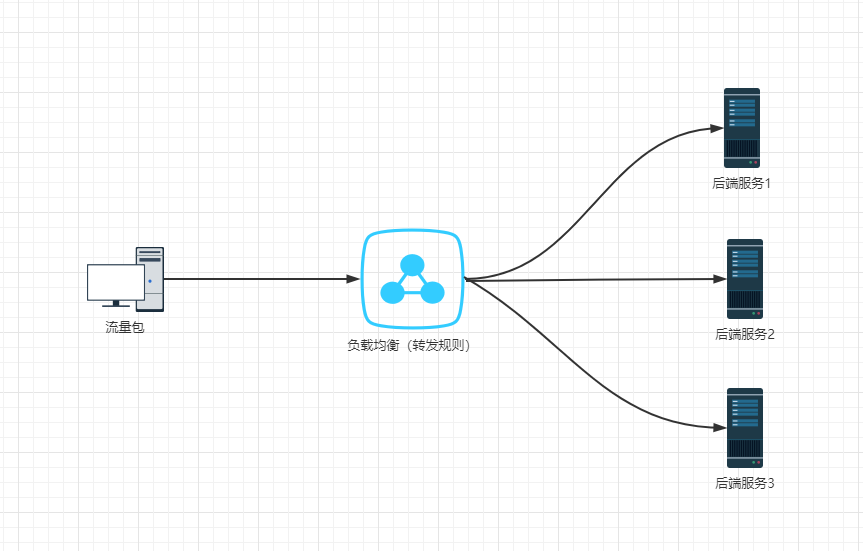
1.2 客户端负载均衡和服务端负载均衡
1.2.1 客户端负载均衡
- 客户端会有一个服务器地址列表,在发送请求前通过负载均衡算法选择一个服务器,进行访问;即在客户端进行负载均衡算法分配。
- 典型应用:Ribbon是客户端负载均衡。
1.2.2 服务端负载均衡
- 先发送请求到负载均衡服务器或软件,然后通过负载均衡算法,在多个服务器之间选择一个进行访问;即在服务器端进行负载均衡算法分配。
- 典型应用:
 硬件:F5等。
硬件:F5等。 软件:Nginx等。
软件:Nginx等。
2 基于Ribbon实现负载均衡
2.1 搭建环境
- 准备两个商品微服务(端口分别是9001和9011)让其注册到Eureka集群中。
- 商品微服务9001的application.yml:
server: port: 9001 # 微服务的端口号spring: application: name: service-product # 微服务的名称 datasource: url: jdbc:mysql://192.168.1.57:3306/test?useUnicode=true&characterEncoding=UTF-8&autoReconnect=true&useSSL=false&serverTimezone=GMT%2B8&allowPublicKeyRetrieval=true driver-class-name: com.mysql.cj.jdbc.Driver username: root password: 123456 jpa: generate-ddl: true show-sql: true open-in-view: true database: mysql# 配置 eurekaeureka: instance: # 主机名称:服务名称修改,其实就是向eureka server中注册的实例id instance-id: service-product:9001 # 显示IP信息 prefer-ip-address: true client: service-url: # 此处修改为 Eureka Server的集群地址 defaultZone: http://eureka7001.com:7001/eureka/,http://eureka7002.com:7002/eureka/,http://eureka7003.com:7003/eureka/# 微服务info内容详细信息info: app.name: xxx company.name: xxx build.artifactId: $project.artifactId$ build.version: $project.version$
- 商品微服务9011的application.yml:
server: port: 9011 # 微服务的端口号spring: application: name: service-product # 微服务的名称 datasource: url: jdbc:mysql://192.168.1.57:3306/test?useUnicode=true&characterEncoding=UTF-8&autoReconnect=true&useSSL=false&serverTimezone=GMT%2B8&allowPublicKeyRetrieval=true driver-class-name: com.mysql.cj.jdbc.Driver username: root password: 123456 jpa: generate-ddl: true show-sql: true open-in-view: true database: mysql# 配置 eurekaeureka: instance: # 主机名称:服务名称修改,其实就是向eureka server中注册的实例id instance-id: service-product:9011 # 显示IP信息 prefer-ip-address: true client: service-url: # 此处修改为 Eureka Server的集群地址 defaultZone: http://eureka7001.com:7001/eureka/,http://eureka7002.com:7002/eureka/,http://eureka7003.com:7003/eureka/# 微服务info内容详细信息info: app.name: xxx company.name: xxx build.artifactId: $project.artifactId$ build.version: $project.version$
- 商品微服务9001和9011的ProductController.java
package com.sunxiaping.product.controller;import com.sunxiaping.product.domain.Product;import com.sunxiaping.product.service.ProductService;import org.springframework.beans.factory.annotation.Autowired;import org.springframework.beans.factory.annotation.Value;import org.springframework.web.bind.annotation.*;@RestController@RequestMapping(value = "/product")public class ProductController { @Autowired private ProductService productService; @Value("${server.port}") private String port; @Value("${spring.cloud.client.ip-address}") private String ip; @PostMapping(value = "/save") public String save(@RequestBody Product product) { productService.save(product); return "新增成功"; } @GetMapping(value = "/findById/{id}") public Product findById(@PathVariable(value = "id") Long id) { Product product = productService.findById(id); product.setProductName("访问的地址是:" + ip + ":" + port); return product; }}
- 订单微服务的OrderController.java
package com.sunxiaping.order.controller;import com.sunxiaping.order.domain.Product;import org.springframework.beans.factory.annotation.Autowired;import org.springframework.cloud.client.discovery.DiscoveryClient;import org.springframework.web.bind.annotation.GetMapping;import org.springframework.web.bind.annotation.PathVariable;import org.springframework.web.bind.annotation.RequestMapping;import org.springframework.web.bind.annotation.RestController;import org.springframework.web.client.RestTemplate;@RestController@RequestMapping(value = "/order")public class OrderController { @Autowired private RestTemplate restTemplate; /** * SpringCloud提供的获取元数据的工具类 * 调用方法获取服务的元数据 */ @Autowired private DiscoveryClient discoveryClient; /** * 基于Ribbon的形式调用远程的微服务 * * @param id * @return */ @GetMapping(value = "/buy/{id}") public Product buy(@PathVariable(value = "id") Long id) { Product product = restTemplate.getForObject("http://service-product/product/findById/" + id, Product.class); return product; }}
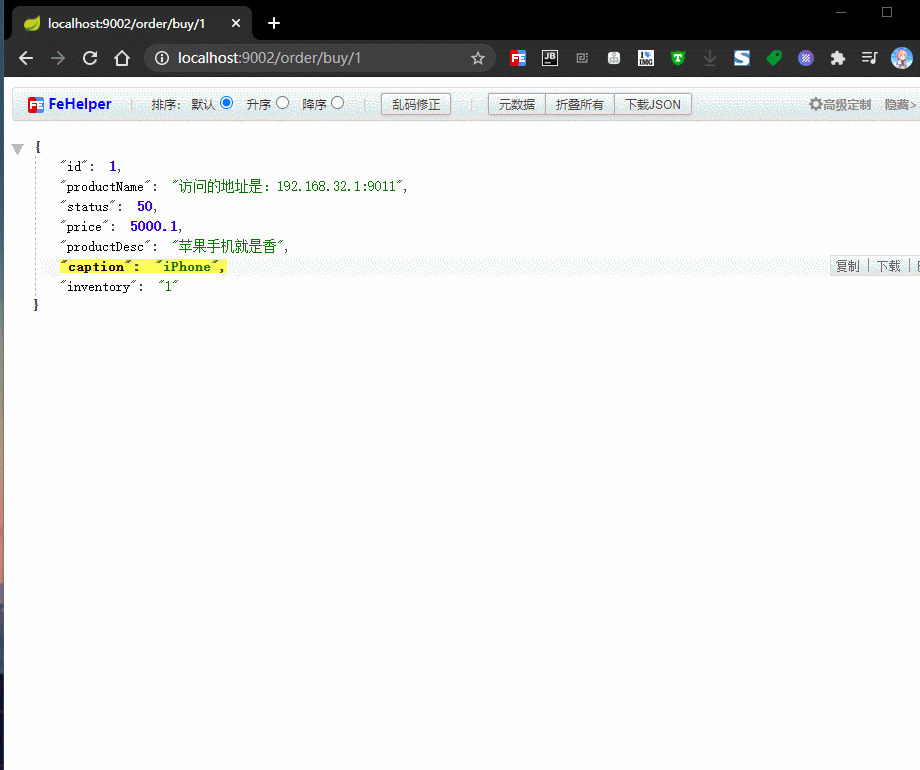
2.2 Ribbon内置的负载均衡策略
2.2.1 Ribbon内置的负载均衡策略的概述
- Ribbon内置了多种负载均衡策略,内部负责复杂均衡的顶层接口为com.netflix.loadbalancer.IRule,实现方式如下:
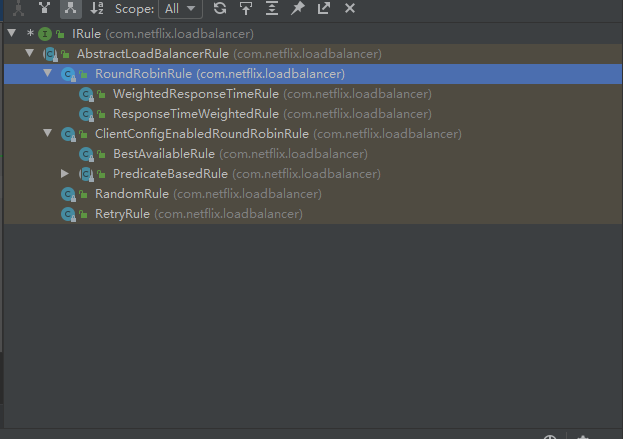
- com.netflix.loadbalancer.RoundRobinRule:以轮询的方式进行负载均衡。
- com.netflix.loadbalancer.RandomRule:随机策略。
- com.netflix.loadbalancer.RetryRule:重试策略。
- com.netflix.loadbalancer.WeightedResponseTimeRule:权重策略。会计算每个服务的权重,权重越高的被调用的可能性会越大。
- com.netflix.loadbalancer.BestAvailableRule:最佳策略。遍历所有的服务实例,过滤掉故障实例,并将请求数量最小的实例返回。
- com.netflix.loadbalancer.AvailabilityFilteringRule:可用过滤策略。过滤掉故障和请求数超过阈值的服务实例,再从剩下的实例中轮询调用。
2.2.2 Ribbon内置的负载均衡策略的使用一
- 在服务消费者的application.yml中修改负载均衡策略:
# 修改ribbon的负载均衡策略 服务名 - ribbon - NFLoadBalancerRuleClassName :负载均衡策略service-product: ribbon: NFLoadBalancerRuleClassName: com.netflix.loadbalancer.RandomRule # 修改ribbon的负载均衡策略为权重策略
server: port: 9002 # 微服务的端口号spring: application: name: service-order # 微服务的名称 datasource: url: jdbc:mysql://192.168.1.57:3306/test?useUnicode=true&characterEncoding=UTF-8&autoReconnect=true&useSSL=false&serverTimezone=GMT%2B8&allowPublicKeyRetrieval=true driver-class-name: com.mysql.cj.jdbc.Driver username: root password: 123456 jpa: generate-ddl: true show-sql: true open-in-view: true database: mysql# 配置Eurekaeureka: instance: # 实例的名称 instance-id: service-order:9002 # 显示IP信息 prefer-ip-address: true lease-renewal-interval-in-seconds: 5 # 发送心跳续约间隔(默认30秒) lease-expiration-duration-in-seconds: 10 # Eureka Client发送心跳给Eureka Server端后,续约到期时间(默认90秒) client: healthcheck: enabled: true service-url: # Eureka Server的地址 # defaultZone: http://localhost:9000/eureka/ defaultZone: http://eureka7001.com:7001/eureka/,http://eureka7002.com:7002/eureka/# 修改ribbon的负载均衡策略 服务名 - ribbon - NFLoadBalancerRuleClassName :负载均衡策略service-product: ribbon: NFLoadBalancerRuleClassName: com.netflix.loadbalancer.RandomRule # 修改ribbon的负载均衡策略为权重策略# 微服务info内容详细信息info: app.name: xxx company.name: xxx build.artifactId: $project.artifactId$ build.version: $project.version$
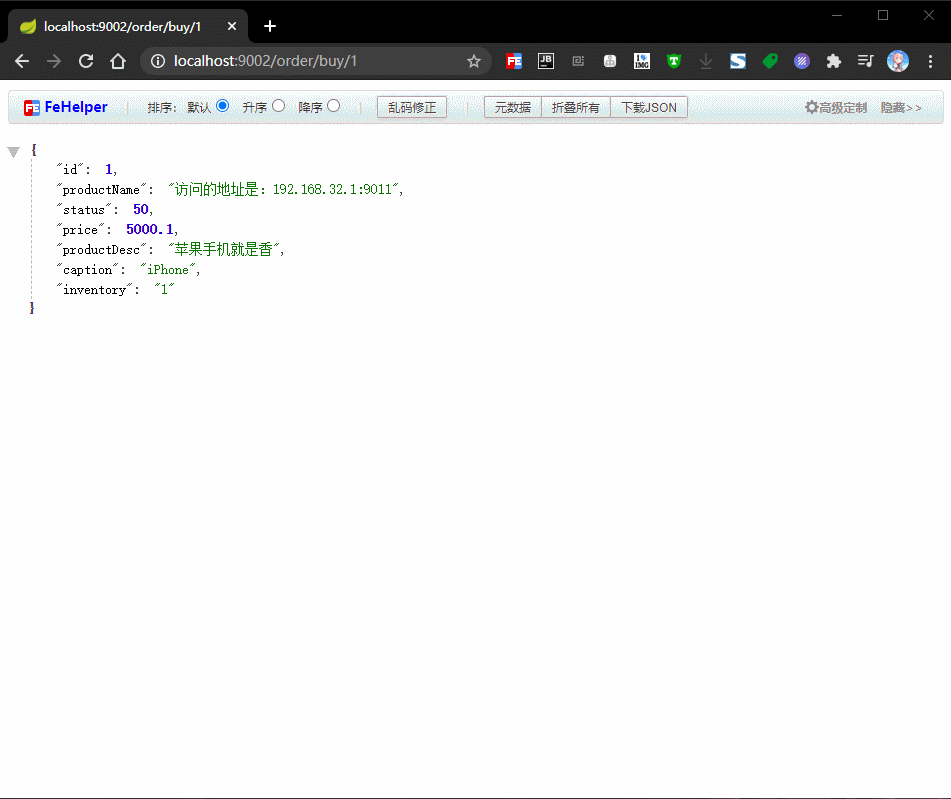
2.2.3 Ribbon内置的负载均衡策略的使用二
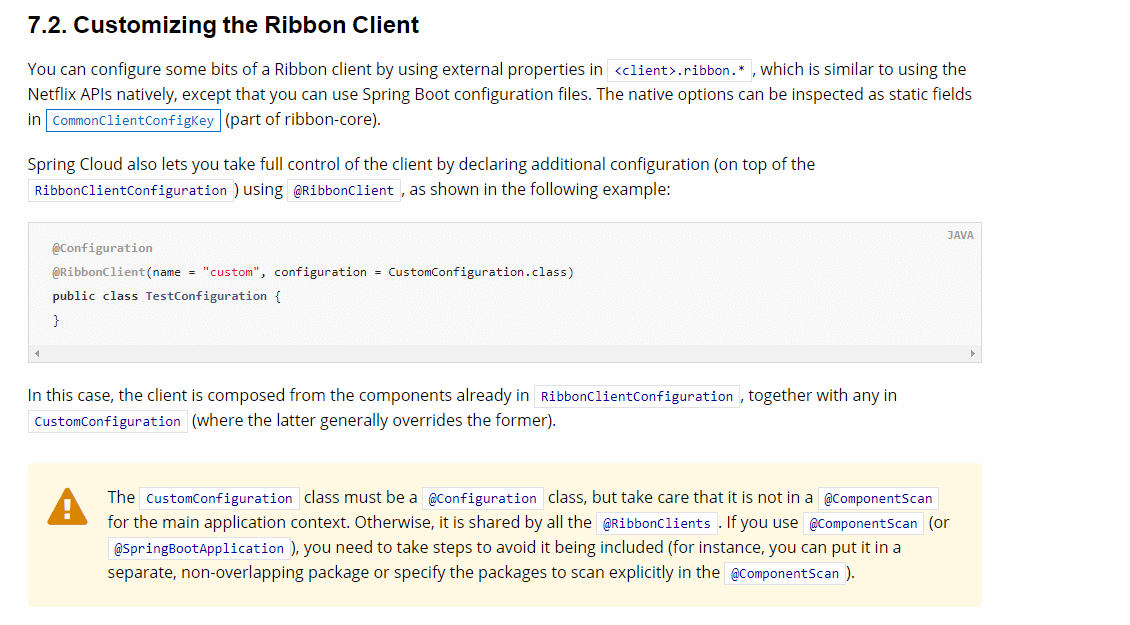
- 在启动类扫描不到的地方新建一个自定义的Rule配置类(比如启动类的包名是com.sunxiaping.order,而自定义Rule配置类的包名是com.sunxiaping.ribbon.rule)。
package com.sunxiaping.ribbon.rule;import com.netflix.loadbalancer.IRule;import com.netflix.loadbalancer.RandomRule;import org.springframework.context.annotation.Bean;import org.springframework.context.annotation.Configuration;@Configurationpublic class SelfRule { /** * 替换Ribbon内置的负载均衡策略 * * @return */ @Bean public IRule iRule() { return new RandomRule(); }}
package com.sunxiaping.order;import com.sunxiaping.ribbon.rule.SelfRule;import org.springframework.boot.SpringApplication;import org.springframework.boot.autoconfigure.SpringBootApplication;import org.springframework.cloud.netflix.eureka.EnableEurekaClient;import org.springframework.cloud.netflix.ribbon.RibbonClient;@SpringBootApplication@EnableEurekaClient//在启动类上标注@RibbonClient注解,这样该微服务启动的时候就能去加载自定义的Ribbon配置类,从而使得配置生效@RibbonClient(name = "service-product",configuration = SelfRule.class)public class OrderApplication { public static void main(String[] args) { SpringApplication.run(OrderApplication.class, args); }}
2.2.4 Ribbon的策略选择
- 如果每个机器配置一样,建议不修改策略(推荐)。
- 如果部分机器配置强,则可以改为WeightedResponseTimeRule。
2.3 请求重试机制
- 在实际生产环境中,Ribbon做客户端负载均衡的时候,Ribbon默认的负载均衡算法是轮询,一旦访问到的那台微服务提供者突然宕机了,此时就会出现404的情况,这时可以使用Ribbon的请求重试机制,Ribbon的请求重试机制基于Spring的retry(Spring的重试框架)。
- 使用:
 在微服务消费者导入spring-retry的Maven坐标:
在微服务消费者导入spring-retry的Maven坐标:
<dependency> <groupId>org.springframework.retry</groupId> <artifactId>spring-retry</artifactId></dependency>
 修改微服务消费者的application.yml:
修改微服务消费者的application.yml:- 修改部分:
# Ribbon的重试机制service-product: ribbon:# 修改ribbon的负载均衡策略 服务名 - ribbon - NFLoadBalancerRuleClassName :负载均衡策略# NFLoadBalancerRuleClassName: com.netflix.loadbalancer.RandomRule # 修改ribbon的负载均衡策略为权重策略 # Ribbon的重试机制参数 ConnectTimeout: 250 # Ribbon的连接超时时间 ReadTimeout: 1000 # Ribbon的数据读取超时时间 OkToRetryOnAllOperations: true # 是否对所有操作都进行重试 MaxAutoRetriesNextServer: 2 # 切换实例的重试次数 MaxAutoRetries: 1 # 对当前实例的重试次数
server: port: 9002 # 微服务的端口号spring: application: name: service-order # 微服务的名称 datasource: url: jdbc:mysql://192.168.1.57:3306/test?useUnicode=true&characterEncoding=UTF-8&autoReconnect=true&useSSL=false&serverTimezone=GMT%2B8&allowPublicKeyRetrieval=true driver-class-name: com.mysql.cj.jdbc.Driver username: root password: 123456 jpa: generate-ddl: true show-sql: true open-in-view: true database: mysql# 配置Eurekaeureka: instance: # 实例的名称 instance-id: service-order:9002 # 显示IP信息 prefer-ip-address: true lease-renewal-interval-in-seconds: 5 # 发送心跳续约间隔(默认30秒) lease-expiration-duration-in-seconds: 10 # Eureka Client发送心跳给Eureka Server端后,续约到期时间(默认90秒) client: healthcheck: enabled: true service-url: # Eureka Server的地址 # defaultZone: http://localhost:9000/eureka/ defaultZone: http://eureka7001.com:7001/eureka/,http://eureka7002.com:7002/eureka/# Ribbon的重试机制service-product: ribbon:# 修改ribbon的负载均衡策略 服务名 - ribbon - NFLoadBalancerRuleClassName :负载均衡策略# NFLoadBalancerRuleClassName: com.netflix.loadbalancer.RandomRule # 修改ribbon的负载均衡策略为权重策略 # Ribbon的重试机制参数 ConnectTimeout: 250 # Ribbon的连接超时时间 ReadTimeout: 1000 # Ribbon的数据读取超时时间 OkToRetryOnAllOperations: true # 是否对所有操作都进行重试 MaxAutoRetriesNextServer: 2 # 切换实例的重试次数 MaxAutoRetries: 1 # 对当前实例的重试次数# 微服务info内容详细信息info: app.name: xxx company.name: xxx build.artifactId: $project.artifactId$ build.version: $project.version$# 开启日志debuglogging: level: root: debug
3 Ribbon中负载均衡的源码分析
3.1 Ribbon中的关键组件
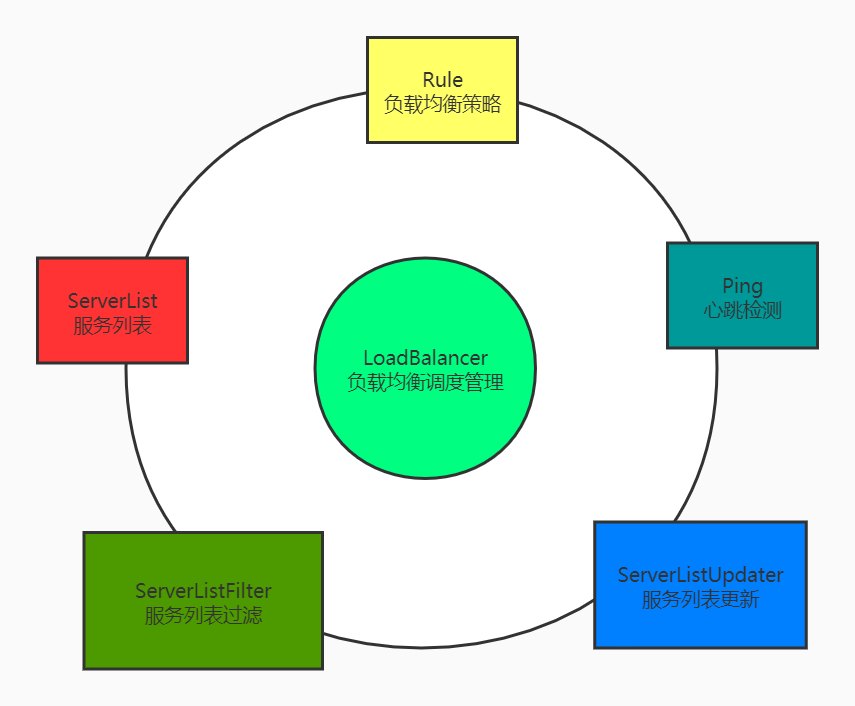
- ServerList:可以响应客户端的特定服务的服务器列表。
- ServerListFilter:可以动态获取具有所需特征的候选服务器列表的过滤器。
- ServetListUpdater:用于执行动态服务器的列表更新。
- Rule:负载均衡策略,用于确定从服务器列表返回哪个服务器。
- Ping:客户端用于快速检查服务器当时是否处于活动状态。
- LoaderBalancer:负载均衡器,负载负载均衡调度的管理。
3.2 @LoadBalanced注解
- 使用Ribbon完成客户端负载均衡往往是从一个注解开始的:
package com.sunxiaping.order.config;import org.springframework.cloud.client.loadbalancer.LoadBalanced;import org.springframework.context.annotation.Bean;import org.springframework.context.annotation.Configuration;import org.springframework.web.client.RestTemplate;@Configurationpublic class SpringConfig { @Bean @LoadBalanced public RestTemplate restTemplate() { return new RestTemplate(); }}
/** * Annotation to mark a RestTemplate bean to be configured to use a LoadBalancerClient. * @author Spencer Gibb */@Target({ ElementType.FIELD, ElementType.PARAMETER, ElementType.METHOD })@Retention(RetentionPolicy.RUNTIME)@Documented@Inherited@Qualifierpublic @interface LoadBalanced {}
- 可以知道@LoadBalanced注解就是用来给RestTemplate做标记,方便我们对RestTemplate添加一个LoadBalancerClient,以实现客户端负载均衡。
3.3 自动装配
- 根据SpringBoot中的自动装配规则可以在
spring-cloud-netflix-ribbon-2.1.0.RELEASE.jar中找到spring.factories,内容如下:
org.springframework.boot.autoconfigure.EnableAutoConfiguration=\org.springframework.cloud.netflix.ribbon.RibbonAutoConfiguration
- RibbonAutoConfiguration的部分源码如下:
@Configuration@Conditional({RibbonAutoConfiguration.RibbonClassesConditions.class})@RibbonClients@AutoConfigureAfter( name = {"org.springframework.cloud.netflix.eureka.EurekaClientAutoConfiguration"})@AutoConfigureBefore({LoadBalancerAutoConfiguration.class, AsyncLoadBalancerAutoConfiguration.class})@EnableConfigurationProperties({RibbonEagerLoadProperties.class, ServerIntrospectorProperties.class})public class RibbonAutoConfiguration { @Autowired( required = false ) private List<RibbonClientSpecification> configurations = new ArrayList(); @Autowired private RibbonEagerLoadProperties ribbonEagerLoadProperties; public RibbonAutoConfiguration() { } //其他略}
- 可以知道RibbonAutoConfiguration引入了LoadBalancerAutoConfiguration配置类。
3.4 负载均衡调用
- LoadBalancerAutoConfiguration的源码如下:
@Configuration@ConditionalOnClass(RestTemplate.class)@ConditionalOnBean(LoadBalancerClient.class)@EnableConfigurationProperties(LoadBalancerRetryProperties.class)public class LoadBalancerAutoConfiguration { @LoadBalanced @Autowired(required = false) private List<RestTemplate> restTemplates = Collections.emptyList(); @Bean public SmartInitializingSingleton loadBalancedRestTemplateInitializerDeprecated( final ObjectProvider<List<RestTemplateCustomizer>> restTemplateCustomizers) { return () -> restTemplateCustomizers.ifAvailable(customizers -> { for (RestTemplate restTemplate : LoadBalancerAutoConfiguration.this.restTemplates) { for (RestTemplateCustomizer customizer : customizers) { customizer.customize(restTemplate); } } }); } @Autowired(required = false) private List<LoadBalancerRequestTransformer> transformers = Collections.emptyList(); @Bean @ConditionalOnMissingBean public LoadBalancerRequestFactory loadBalancerRequestFactory( LoadBalancerClient loadBalancerClient) { return new LoadBalancerRequestFactory(loadBalancerClient, transformers); } @Configuration @ConditionalOnMissingClass("org.springframework.retry.support.RetryTemplate") static class LoadBalancerInterceptorConfig { //①创建LoadBalancerInterceptor的Bean,用于实现对客户端请求进行拦截,以实现客户端负载均衡 @Bean public LoadBalancerInterceptor ribbonInterceptor( LoadBalancerClient loadBalancerClient, LoadBalancerRequestFactory requestFactory) { return new LoadBalancerInterceptor(loadBalancerClient, requestFactory); } //②创建RestTemplateCustomizer的Bean,用于给RestTemplate增加LoadBalancerInterceptor烂机器。 @Bean @ConditionalOnMissingBean public RestTemplateCustomizer restTemplateCustomizer( final LoadBalancerInterceptor loadBalancerInterceptor) { return restTemplate -> { //③维护了一个被@LoadBalanced注解修饰的RestTemplate对象列表,并在这里进行初始化,通过调用RestTemplateCustomizer的实例来给需要客户端负载均衡的RestTemplate增加LoadBalancerInterceptor拦截器 List<ClientHttpRequestInterceptor> list = new ArrayList<>( restTemplate.getInterceptors()); list.add(loadBalancerInterceptor); restTemplate.setInterceptors(list); }; } } @Configuration @ConditionalOnClass(RetryTemplate.class) public static class RetryAutoConfiguration { @Bean @ConditionalOnMissingBean public LoadBalancedRetryFactory loadBalancedRetryFactory() { return new LoadBalancedRetryFactory() {}; } } @Configuration @ConditionalOnClass(RetryTemplate.class) public static class RetryInterceptorAutoConfiguration { @Bean @ConditionalOnMissingBean public RetryLoadBalancerInterceptor ribbonInterceptor( LoadBalancerClient loadBalancerClient, LoadBalancerRetryProperties properties, LoadBalancerRequestFactory requestFactory, LoadBalancedRetryFactory loadBalancedRetryFactory) { return new RetryLoadBalancerInterceptor(loadBalancerClient, properties, requestFactory, loadBalancedRetryFactory); } @Bean @ConditionalOnMissingBean public RestTemplateCustomizer restTemplateCustomizer( final RetryLoadBalancerInterceptor loadBalancerInterceptor) { return restTemplate -> { List<ClientHttpRequestInterceptor> list = new ArrayList<>( restTemplate.getInterceptors()); list.add(loadBalancerInterceptor); restTemplate.setInterceptors(list); }; } }}
- 在该自动配置类中,主要做如下的三件事:
 创建一个LoadBalancerInterceptor的Bean,用于实现对客户端发起请求时进行拦截,以实现客户端负载均衡。
创建一个LoadBalancerInterceptor的Bean,用于实现对客户端发起请求时进行拦截,以实现客户端负载均衡。 创建了一个RestTemplateCustomizer的Bean,用于给RestTemplate增加LoadBalancerInterceptor拦截器。
创建了一个RestTemplateCustomizer的Bean,用于给RestTemplate增加LoadBalancerInterceptor拦截器。 维护了一个被@LoadBalanced注解修改的RestTemplate对象列表,并在这里进行初始化,通过调用RestTemplateCustomizer的实例来给需要客户端负载均衡的RestTemplate增加LoadBalancerInterceptor拦截器。
维护了一个被@LoadBalanced注解修改的RestTemplate对象列表,并在这里进行初始化,通过调用RestTemplateCustomizer的实例来给需要客户端负载均衡的RestTemplate增加LoadBalancerInterceptor拦截器。- LoadBalancerInterceptor的源码如下:
public class LoadBalancerInterceptor implements ClientHttpRequestInterceptor { private LoadBalancerClient loadBalancer; private LoadBalancerRequestFactory requestFactory; public LoadBalancerInterceptor(LoadBalancerClient loadBalancer, LoadBalancerRequestFactory requestFactory) { this.loadBalancer = loadBalancer; this.requestFactory = requestFactory; } public LoadBalancerInterceptor(LoadBalancerClient loadBalancer) { // for backwards compatibility this(loadBalancer, new LoadBalancerRequestFactory(loadBalancer)); } @Override public ClientHttpResponse intercept(final HttpRequest request, final byte[] body, final ClientHttpRequestExecution execution) throws IOException { final URI originalUri = request.getURI(); String serviceName = originalUri.getHost(); Assert.state(serviceName != null, "Request URI does not contain a valid hostname: " + originalUri); return this.loadBalancer.execute(serviceName, requestFactory.createRequest(request, body, execution)); }}
- 通过源码和之前的自动化配置类,我们可以看到在拦截器中注入了LoadBalancerClient的实现。当一个被@LoadBalanced注解修饰的RestTemplate对象向外发起HTTP请求时,会被LoadBalancerInterceptor类的intercept方法拦截。
- LoadBalancerClient是一个抽象的负载均衡接口,其实现类是RibbonLoadBalancerClient。
public class RibbonLoadBalancerClient implements LoadBalancerClient { private SpringClientFactory clientFactory; public RibbonLoadBalancerClient(SpringClientFactory clientFactory) { this.clientFactory = clientFactory; } public URI reconstructURI(ServiceInstance instance, URI original) { Assert.notNull(instance, "instance can not be null"); String serviceId = instance.getServiceId(); RibbonLoadBalancerContext context = this.clientFactory.getLoadBalancerContext(serviceId); URI uri; Server server; if (instance instanceof RibbonLoadBalancerClient.RibbonServer) { RibbonLoadBalancerClient.RibbonServer ribbonServer = (RibbonLoadBalancerClient.RibbonServer)instance; server = ribbonServer.getServer(); uri = RibbonUtils.updateToSecureConnectionIfNeeded(original, ribbonServer); } else { server = new Server(instance.getScheme(), instance.getHost(), instance.getPort()); IClientConfig clientConfig = this.clientFactory.getClientConfig(serviceId); ServerIntrospector serverIntrospector = this.serverIntrospector(serviceId); uri = RibbonUtils.updateToSecureConnectionIfNeeded(original, clientConfig, serverIntrospector, server); } return context.reconstructURIWithServer(server, uri); } //根据传入的服务id,从负载均衡中为指定的服务选择一个服务实例 public ServiceInstance choose(String serviceId) { return this.choose(serviceId, (Object)null); } public ServiceInstance choose(String serviceId, Object hint) { Server server = this.getServer(this.getLoadBalancer(serviceId), hint); return server == null ? null : new RibbonLoadBalancerClient.RibbonServer(serviceId, server, this.isSecure(server, serviceId), this.serverIntrospector(serviceId).getMetadata(server)); } //根据传入的服务id,指定的负责均衡器中的服务实例的执行请求 public <T> T execute(String serviceId, LoadBalancerRequest<T> request) throws IOException { return this.execute(serviceId, (LoadBalancerRequest)request, (Object)null); } //根据传入的服务实例,执行请求 public <T> T execute(String serviceId, LoadBalancerRequest<T> request, Object hint) throws IOException { ILoadBalancer loadBalancer = this.getLoadBalancer(serviceId); Server server = this.getServer(loadBalancer, hint); if (server == null) { throw new IllegalStateException("No instances available for " + serviceId); } else { RibbonLoadBalancerClient.RibbonServer ribbonServer = new RibbonLoadBalancerClient.RibbonServer(serviceId, server, this.isSecure(server, serviceId), this.serverIntrospector(serviceId).getMetadata(server)); return this.execute(serviceId, (ServiceInstance)ribbonServer, (LoadBalancerRequest)request); } } //根据传入的服务实例,执行请求 public <T> T execute(String serviceId, ServiceInstance serviceInstance, LoadBalancerRequest<T> request) throws IOException { Server server = null; if (serviceInstance instanceof RibbonLoadBalancerClient.RibbonServer) { server = ((RibbonLoadBalancerClient.RibbonServer)serviceInstance).getServer(); } if (server == null) { throw new IllegalStateException("No instances available for " + serviceId); } else { RibbonLoadBalancerContext context = this.clientFactory.getLoadBalancerContext(serviceId); RibbonStatsRecorder statsRecorder = new RibbonStatsRecorder(context, server); try { T returnVal = request.apply(serviceInstance); statsRecorder.recordStats(returnVal); return returnVal; } catch (IOException var8) { statsRecorder.recordStats(var8); throw var8; } catch (Exception var9) { statsRecorder.recordStats(var9); ReflectionUtils.rethrowRuntimeException(var9); return null; } } } //略}
- 从RibbonLoadBalancerClient代码可以看出,实际负载均衡是通过ILoadBalancer来实现的。

硬件:F5等。
软件:Nginx等。




在微服务消费者导入spring-retry的Maven坐标:
修改微服务消费者的application.yml:

创建一个LoadBalancerInterceptor的Bean,用于实现对客户端发起请求时进行拦截,以实现客户端负载均衡。
创建了一个RestTemplateCustomizer的Bean,用于给RestTemplate增加LoadBalancerInterceptor拦截器。
维护了一个被@LoadBalanced注解修改的RestTemplate对象列表,并在这里进行初始化,通过调用RestTemplateCustomizer的实例来给需要客户端负载均衡的RestTemplate增加LoadBalancerInterceptor拦截器。

